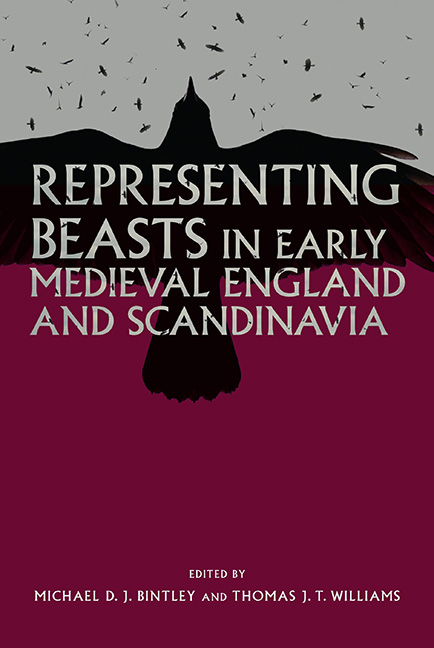Book contents
- Frontmatter
- Contents
- List of Figures and Tables
- Acknowledgements
- List of Contributors
- List of Abbreviations
- Introduction
- 1 Between Myth and Reality: Hunter and Prey in Early Anglo-Saxon Art
- 2 ‘(Swinger of) the Serpent of Wounds’: Swords and Snakes in the Viking Mind
- 3 Wreoþenhilt ond wyrmfah: Confronting Serpents in Beowulf and Beyond
- 4 The Ravens on the Lejre Throne: Avian Identifiers, Odin at Home, Farm Ravens
- 5 Beowulf’s Blithe-Hearted Raven
- 6 Do Anglo-Saxons Dream of Exotic Sheep?
- 7 You Sexy Beast: The Pig in a Villa in Vandalic North Africa, and Boar-Cults in Old Germanic Heathendom
- 8 ‘For the Sake of Bravado in the Wilderness’: Confronting the Bestial in Anglo-Saxon Warfare
- 9 Where the Wild Things Are in Old English Poetry
- 10 Entomological Etymologies: Creepy-Crawlies in English Place-Names
- 11 Beasts, Birds and Other Creatures in Pre-Conquest Charters and Place-Names in England
- Index
- Anglo-Saxon Studies
2 - ‘(Swinger of) the Serpent of Wounds’: Swords and Snakes in the Viking Mind
Published online by Cambridge University Press: 11 June 2021
- Frontmatter
- Contents
- List of Figures and Tables
- Acknowledgements
- List of Contributors
- List of Abbreviations
- Introduction
- 1 Between Myth and Reality: Hunter and Prey in Early Anglo-Saxon Art
- 2 ‘(Swinger of) the Serpent of Wounds’: Swords and Snakes in the Viking Mind
- 3 Wreoþenhilt ond wyrmfah: Confronting Serpents in Beowulf and Beyond
- 4 The Ravens on the Lejre Throne: Avian Identifiers, Odin at Home, Farm Ravens
- 5 Beowulf’s Blithe-Hearted Raven
- 6 Do Anglo-Saxons Dream of Exotic Sheep?
- 7 You Sexy Beast: The Pig in a Villa in Vandalic North Africa, and Boar-Cults in Old Germanic Heathendom
- 8 ‘For the Sake of Bravado in the Wilderness’: Confronting the Bestial in Anglo-Saxon Warfare
- 9 Where the Wild Things Are in Old English Poetry
- 10 Entomological Etymologies: Creepy-Crawlies in English Place-Names
- 11 Beasts, Birds and Other Creatures in Pre-Conquest Charters and Place-Names in England
- Index
- Anglo-Saxon Studies
Summary
The existence of a link between snakes and swords in Viking thought has long been suspected. Poetry dated to the Viking period (roughly 750–1050) likens swords to serpents, while snakes are part of the menagerie of animals used to decorate sword fittings (and other artefacts) at this time. Comparisons have also been drawn between literary descriptions of sword blades and real swords made by pattern-welding, a technique that created blades with sinuous, serpentine designs. These correlations seem neat, but there are hints of greater complexity underneath. In recent years, research into the relationship between humans, animals and artefacts has shown that the boundaries between these categories were once far less defined than they are today. In early medieval thinking, any one of these categories could acquire the qualities of another, and shapeshifting was possible. As a result, it has become helpful to view the members of these categories as co-existent ‘beings’ which were not taxonomically separate. These themes, which have formed part of the impetus for this volume, offer a useful framework within which to explore and understand the Vikings’ cognitive link between swords and snakes.
This chapter constitutes an interdisciplinary study of the relationship between swords and snakes in Viking thought. The evidence is reviewed and analysed in order to determine the strength and significance of the link, and explanations are proposed. The geographical and temporal focus is Viking Scandinavia, although evidence from other regions where Scandinavians settled or were active is discussed where relevant. Literary and archaeological sources form the core of the enquiry, and the parallels between them are assessed. All evidence is viewed in proper context: this is vital because snakes were not the only animals that were associated with swords in Viking Scandinavia. These relationships must also be considered if the sword-snake link is to be properly understood.
Firstly, it is necessary to negotiate a perennial problem relating to written sources. Before the spread of Christianity from the mid-tenth century, an oral culture prevailed in Scandinavia, and literacy was extremely limited. The only truly contemporary texts of the era are runic inscriptions on monuments and portable artefacts, which, due to their formulaic and/or commemorative nature, contain little information that is useful for this enquiry. A rich body of later texts survives in the form of Icelandic sagas, written down from the twelfth century, with many set in the Viking period.
- Type
- Chapter
- Information
- Publisher: Boydell & BrewerPrint publication year: 2015
- 6
- Cited by



